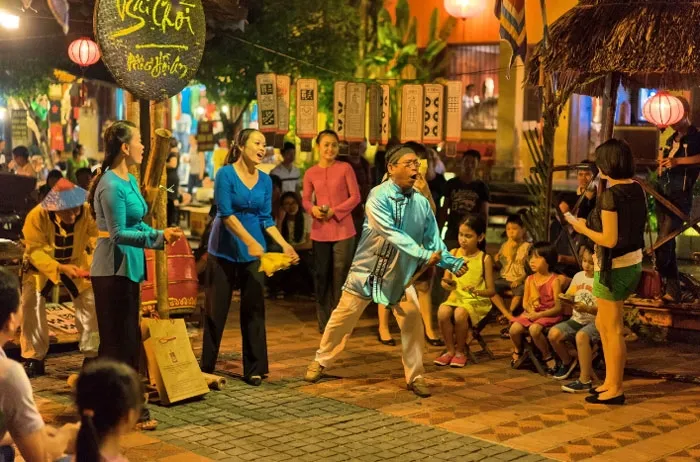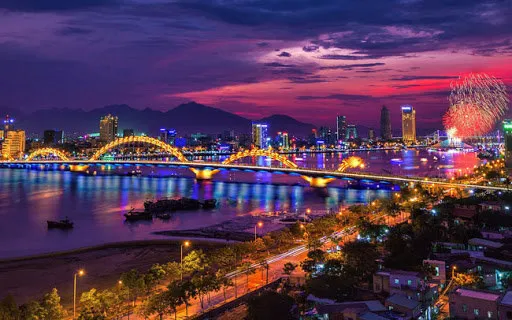
This initiative is intended to invigorate the expansion of nighttime offerings within the tourism sector, contributing to the growth of Vietnam's night economy. However, concerns have been raised that the similarity of products among different localities could lead to ineffectiveness.
Spending opportunities needed
Around five years ago, discussions around the development of night tourism products were fervent among numerous travel enterprises. The prevailing sentiment was that after 6 pm, tourists—especially international ones—lacked places for entertainment, despite having disposable income they were unable to spend.
Mr. Nguyễn Quốc Kỳ, Chairman of the Board of Directors of Vietravel Holdings and an advocate for night tourism product development, emphasized that the demand for spending among tourists at night is substantial, accounting for approximately 70% of their total expenses during the trip. However, there is a dearth of nighttime activities and products, a situation that has contributed to the relatively low expenditure by visitors to Vietnam.
A survey by the General Department of Tourism highlighted that, in 2018, international visitors' spending in Vietnam predominantly went towards accommodations and dining (representing 56-60% of expenses). Purchases of goods, souvenirs, sightseeing, and entertainment accounted for 20%, with the remaining portion attributed to other expenses. Specifically, costs associated with sightseeing and entertainment constituted merely 7-10% of the overall trip expenditure. In contrast, this figure stood at 40-50% for countries like Malaysia and Thailand.
Another striking statistic is that, over the course of a decade, the growth in tourist spending while in Vietnam has only increased by 1.2 times. In 2009, the average spending of foreign tourists during their stay in Vietnam was USD 1,000 per guest. By 2019—the year considered the peak of attracting international visitors—the figure had inched up to USD 1,200 per guest. While spending on food and travel had risen, expenditures on entertainment and sightseeing remained virtually unchanged. In comparison, in 2019, tourists visiting Thailand spent an average of USD 2,400-2,500 per person, contributing to a total value of USD 63 billion for night tourism, which accounted for 11% of the entire tourism industry's value. The Thai Ministry of Tourism and Sports projected that extending operating hours for leisure facilities would result in a 25% increase in visitor spending.
Confronted with these realities, in July 2020, the Prime Minister issued Decision No. 1129/QD-TTg, endorsing a project for the development of the night economy in Vietnam. The initial phase of this project prioritized tourism development and led to the issuance of open policies, such as extended operating hours for certain services. However, the implementation of these policies was impeded by the outbreak of the Covid-19 pandemic. Most recently, the Ministry of Culture, Sports, and Tourism released a project targeting the development of diverse night tourism product models across 12 prominent destinations, including Hanoi, Quang Ninh, Hai Phong, Thua Thien - Hue, Da Nang, Khanh Hoa, Hoi An (Quang Nam), Da Lat (Lam Dong), Can Tho, Phu Quoc (Kien Giang), HCMC, and Ba Ria - Vung Tau, stipulating the development of at least one night tourism product model for each location.
Averting conformity and trend-following
In reality, even before the Ministry of Culture, Sports, and Tourism introduced this project, several localities had proactively devised solutions for developing their night economies, predominantly centered around tourism. An illustrative example is Da Nang, which swiftly initiated a project to cultivate its night economy, involving activities such as leveraging My An night beach, establishing An Thuong pedestrian street, introducing water/fire displays at the Dragon Bridge, organizing events at the Helio night market, and launching the Son Tra night market. Similarly, Hanoi has been highly active in crafting night tourism products. In addition to the renowned Ta Hien Street, the city has achieved success with night tours at Hoa Lo Prison ruins, night tours of the Thang Long Imperial Citadel, and literary tours at the Vietnam Literature Museum.
 |
Ho Chi Minh City, likewise, is committed to establishing itself as the "city that never sleeps." Alongside popular destinations like Bùi Viện, Nguyễn Huệ, and Bến Thành night markets, the city has initiated several night market and walking street projects. Furthermore, the tourism sector of Ho Chi Minh City is introducing a unique offering called "Mystical Saigon Night." More recently, Khanh Hoa province has greenlit a project focused on cultural activities and nighttime entertainment as part of its night economy development efforts.
Reflecting on the participation of localities in night tourism product development and the night economy, Mr. Đặng Mạnh Phước, Executive Director of The Outbox Company, remarked that localities' enthusiasm for nurturing night tourism products and services is a promising sign. Encouraging examples include Hanoi's implementation of a night tour at the Hỏa Lò Prison relic. However, it must be acknowledged that many localities are currently adopting a shared development model for night products, often featuring pedestrian streets, food markets, and cultural and entertainment activities, though these might not be sustainable through the entirety of the night (and certainly not until morning).
A tourism business director expressed concern over a conformist approach, where localities follow similar trends. He emphasized the importance of each locality creating products and services tailored to its own resources and strengths. In reality, pursuing a "one-size-fits-all" approach has led to the premature decline of some pedestrian streets and food markets in certain regions.




















